ERP Systems in the Cloud: On-Premise, Hosted, and Cloud ERP Systems
VerifiedAdded on 2023/06/11
|17
|5093
|421
AI Summary
This report discusses the different types of ERP systems - On-Premise, Hosted, and Cloud ERP Systems. It provides a brief history of ERP systems and their evolution. The report includes case studies of Water Corporation Company and Scottish Fire and Rescue Services (SFRS) to illustrate the benefits and weaknesses of On-Premise and Hosted ERP systems. The report also discusses Cloud ERP systems and their benefits and weaknesses.
Contribute Materials
Your contribution can guide someone’s learning journey. Share your
documents today.
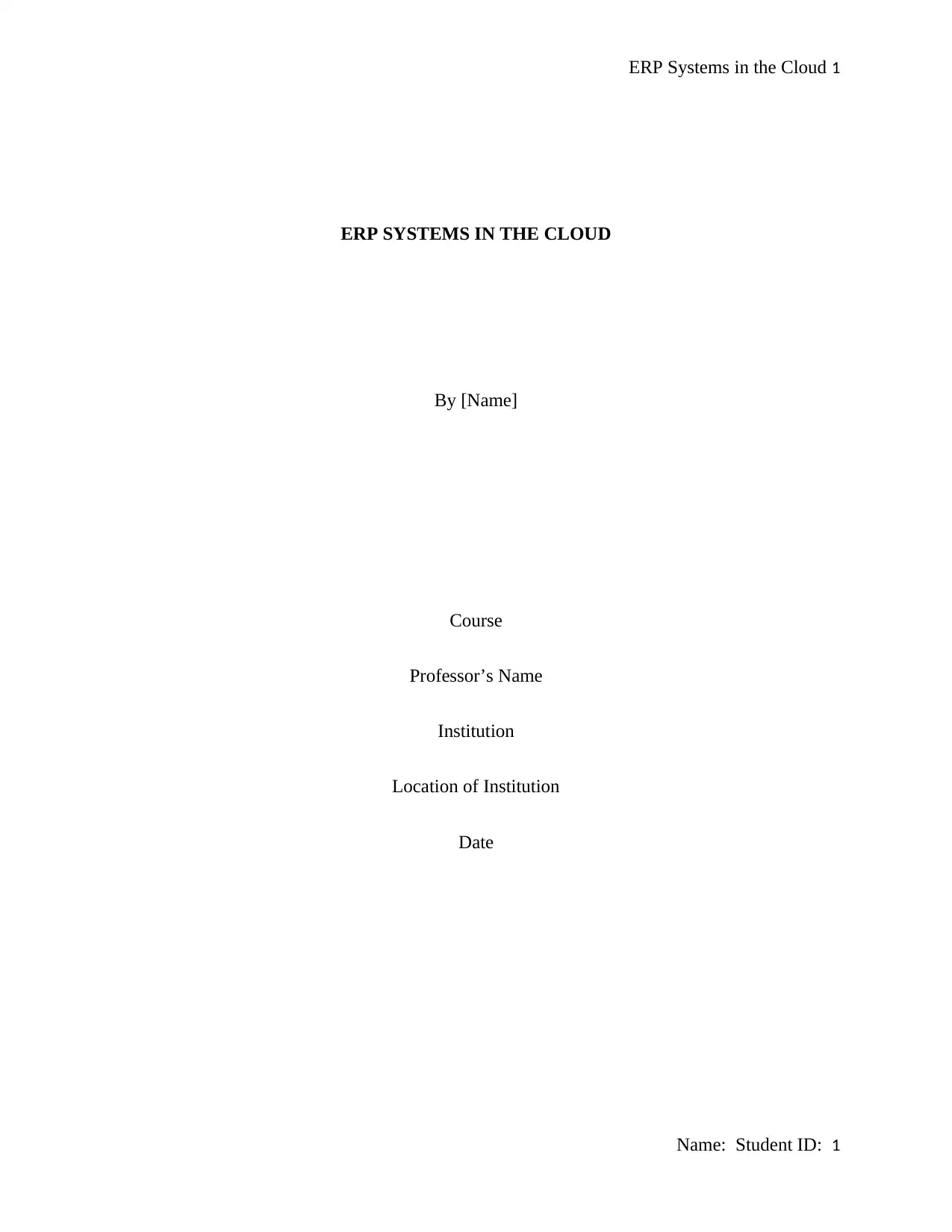
ERP Systems in the Cloud 1
ERP SYSTEMS IN THE CLOUD
By [Name]
Course
Professor’s Name
Institution
Location of Institution
Date
Name: Student ID: 1
ERP SYSTEMS IN THE CLOUD
By [Name]
Course
Professor’s Name
Institution
Location of Institution
Date
Name: Student ID: 1
Secure Best Marks with AI Grader
Need help grading? Try our AI Grader for instant feedback on your assignments.
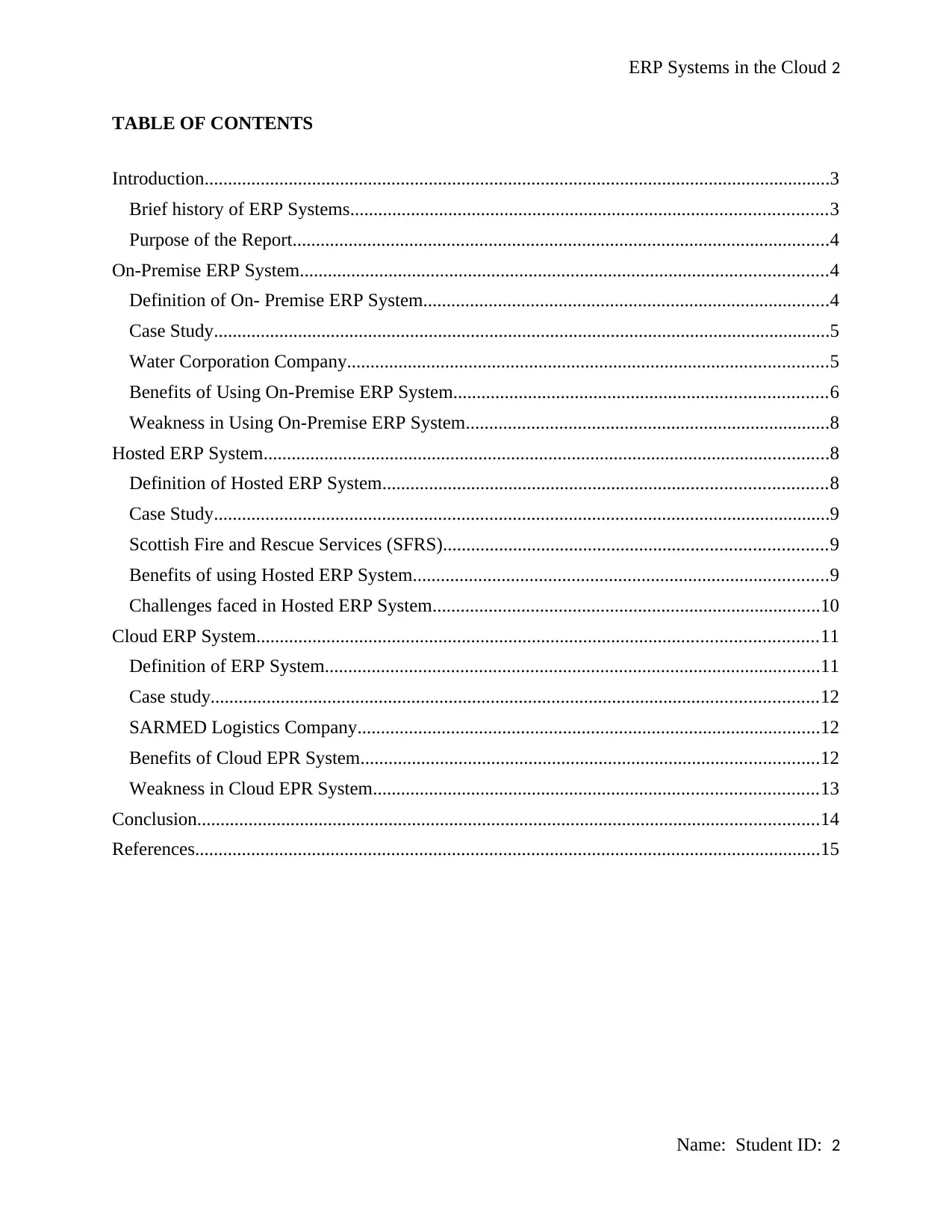
ERP Systems in the Cloud 2
TABLE OF CONTENTS
Introduction......................................................................................................................................3
Brief history of ERP Systems......................................................................................................3
Purpose of the Report...................................................................................................................4
On-Premise ERP System.................................................................................................................4
Definition of On- Premise ERP System.......................................................................................4
Case Study....................................................................................................................................5
Water Corporation Company.......................................................................................................5
Benefits of Using On-Premise ERP System................................................................................6
Weakness in Using On-Premise ERP System..............................................................................8
Hosted ERP System.........................................................................................................................8
Definition of Hosted ERP System...............................................................................................8
Case Study....................................................................................................................................9
Scottish Fire and Rescue Services (SFRS)..................................................................................9
Benefits of using Hosted ERP System.........................................................................................9
Challenges faced in Hosted ERP System...................................................................................10
Cloud ERP System........................................................................................................................11
Definition of ERP System..........................................................................................................11
Case study..................................................................................................................................12
SARMED Logistics Company...................................................................................................12
Benefits of Cloud EPR System..................................................................................................12
Weakness in Cloud EPR System...............................................................................................13
Conclusion.....................................................................................................................................14
References......................................................................................................................................15
Name: Student ID: 2
TABLE OF CONTENTS
Introduction......................................................................................................................................3
Brief history of ERP Systems......................................................................................................3
Purpose of the Report...................................................................................................................4
On-Premise ERP System.................................................................................................................4
Definition of On- Premise ERP System.......................................................................................4
Case Study....................................................................................................................................5
Water Corporation Company.......................................................................................................5
Benefits of Using On-Premise ERP System................................................................................6
Weakness in Using On-Premise ERP System..............................................................................8
Hosted ERP System.........................................................................................................................8
Definition of Hosted ERP System...............................................................................................8
Case Study....................................................................................................................................9
Scottish Fire and Rescue Services (SFRS)..................................................................................9
Benefits of using Hosted ERP System.........................................................................................9
Challenges faced in Hosted ERP System...................................................................................10
Cloud ERP System........................................................................................................................11
Definition of ERP System..........................................................................................................11
Case study..................................................................................................................................12
SARMED Logistics Company...................................................................................................12
Benefits of Cloud EPR System..................................................................................................12
Weakness in Cloud EPR System...............................................................................................13
Conclusion.....................................................................................................................................14
References......................................................................................................................................15
Name: Student ID: 2
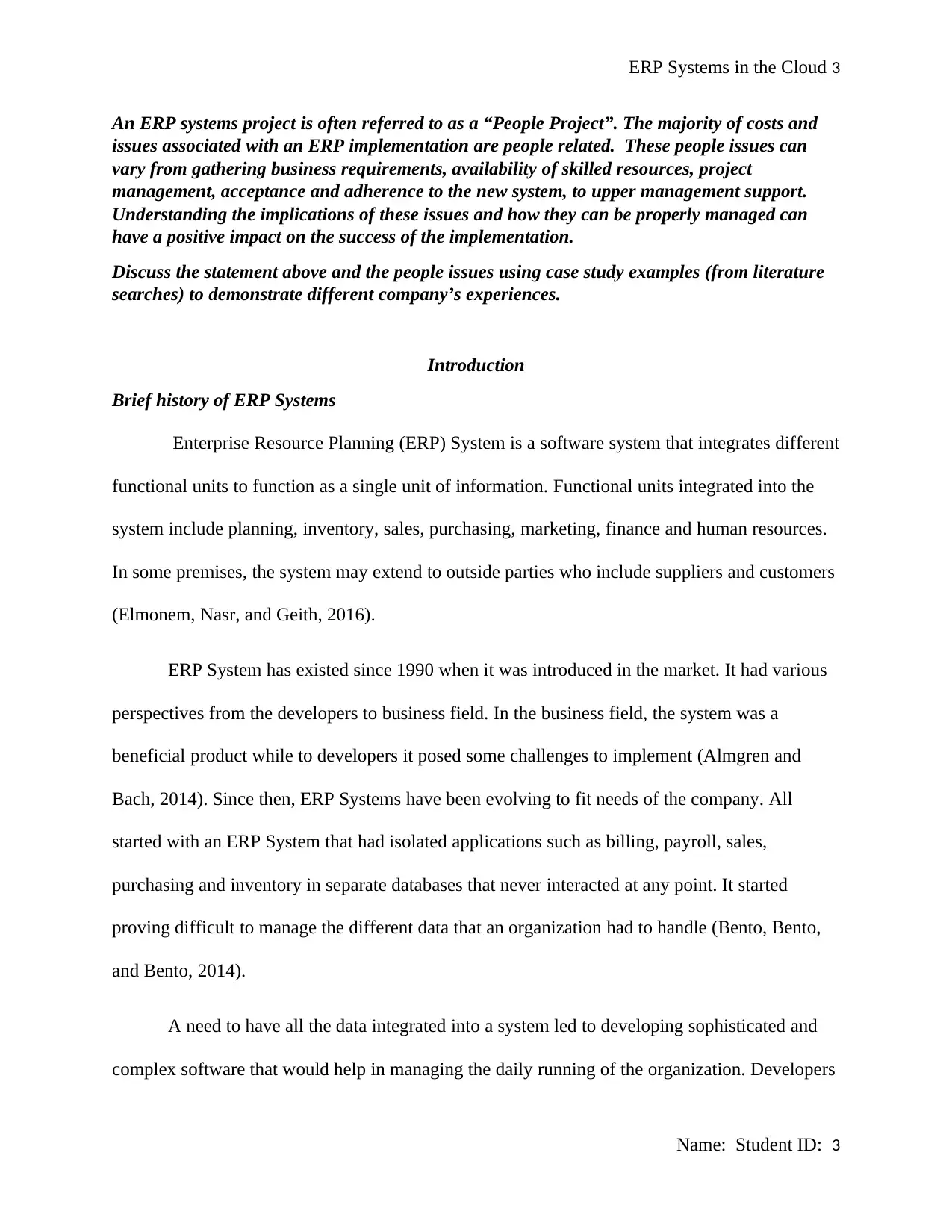
ERP Systems in the Cloud 3
An ERP systems project is often referred to as a “People Project”. The majority of costs and
issues associated with an ERP implementation are people related. These people issues can
vary from gathering business requirements, availability of skilled resources, project
management, acceptance and adherence to the new system, to upper management support.
Understanding the implications of these issues and how they can be properly managed can
have a positive impact on the success of the implementation.
Discuss the statement above and the people issues using case study examples (from literature
searches) to demonstrate different company’s experiences.
Introduction
Brief history of ERP Systems
Enterprise Resource Planning (ERP) System is a software system that integrates different
functional units to function as a single unit of information. Functional units integrated into the
system include planning, inventory, sales, purchasing, marketing, finance and human resources.
In some premises, the system may extend to outside parties who include suppliers and customers
(Elmonem, Nasr, and Geith, 2016).
ERP System has existed since 1990 when it was introduced in the market. It had various
perspectives from the developers to business field. In the business field, the system was a
beneficial product while to developers it posed some challenges to implement (Almgren and
Bach, 2014). Since then, ERP Systems have been evolving to fit needs of the company. All
started with an ERP System that had isolated applications such as billing, payroll, sales,
purchasing and inventory in separate databases that never interacted at any point. It started
proving difficult to manage the different data that an organization had to handle (Bento, Bento,
and Bento, 2014).
A need to have all the data integrated into a system led to developing sophisticated and
complex software that would help in managing the daily running of the organization. Developers
Name: Student ID: 3
An ERP systems project is often referred to as a “People Project”. The majority of costs and
issues associated with an ERP implementation are people related. These people issues can
vary from gathering business requirements, availability of skilled resources, project
management, acceptance and adherence to the new system, to upper management support.
Understanding the implications of these issues and how they can be properly managed can
have a positive impact on the success of the implementation.
Discuss the statement above and the people issues using case study examples (from literature
searches) to demonstrate different company’s experiences.
Introduction
Brief history of ERP Systems
Enterprise Resource Planning (ERP) System is a software system that integrates different
functional units to function as a single unit of information. Functional units integrated into the
system include planning, inventory, sales, purchasing, marketing, finance and human resources.
In some premises, the system may extend to outside parties who include suppliers and customers
(Elmonem, Nasr, and Geith, 2016).
ERP System has existed since 1990 when it was introduced in the market. It had various
perspectives from the developers to business field. In the business field, the system was a
beneficial product while to developers it posed some challenges to implement (Almgren and
Bach, 2014). Since then, ERP Systems have been evolving to fit needs of the company. All
started with an ERP System that had isolated applications such as billing, payroll, sales,
purchasing and inventory in separate databases that never interacted at any point. It started
proving difficult to manage the different data that an organization had to handle (Bento, Bento,
and Bento, 2014).
A need to have all the data integrated into a system led to developing sophisticated and
complex software that would help in managing the daily running of the organization. Developers
Name: Student ID: 3
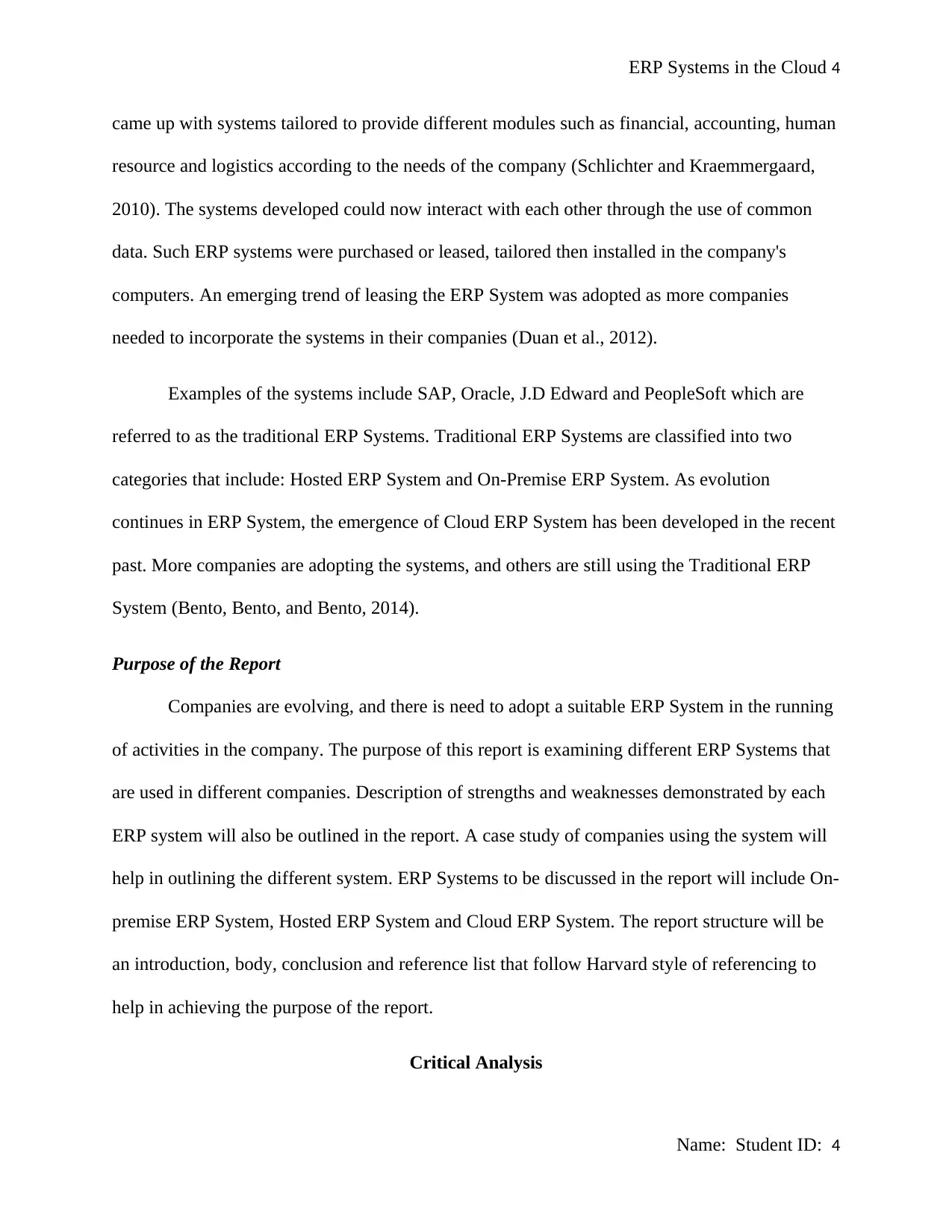
ERP Systems in the Cloud 4
came up with systems tailored to provide different modules such as financial, accounting, human
resource and logistics according to the needs of the company (Schlichter and Kraemmergaard,
2010). The systems developed could now interact with each other through the use of common
data. Such ERP systems were purchased or leased, tailored then installed in the company's
computers. An emerging trend of leasing the ERP System was adopted as more companies
needed to incorporate the systems in their companies (Duan et al., 2012).
Examples of the systems include SAP, Oracle, J.D Edward and PeopleSoft which are
referred to as the traditional ERP Systems. Traditional ERP Systems are classified into two
categories that include: Hosted ERP System and On-Premise ERP System. As evolution
continues in ERP System, the emergence of Cloud ERP System has been developed in the recent
past. More companies are adopting the systems, and others are still using the Traditional ERP
System (Bento, Bento, and Bento, 2014).
Purpose of the Report
Companies are evolving, and there is need to adopt a suitable ERP System in the running
of activities in the company. The purpose of this report is examining different ERP Systems that
are used in different companies. Description of strengths and weaknesses demonstrated by each
ERP system will also be outlined in the report. A case study of companies using the system will
help in outlining the different system. ERP Systems to be discussed in the report will include On-
premise ERP System, Hosted ERP System and Cloud ERP System. The report structure will be
an introduction, body, conclusion and reference list that follow Harvard style of referencing to
help in achieving the purpose of the report.
Critical Analysis
Name: Student ID: 4
came up with systems tailored to provide different modules such as financial, accounting, human
resource and logistics according to the needs of the company (Schlichter and Kraemmergaard,
2010). The systems developed could now interact with each other through the use of common
data. Such ERP systems were purchased or leased, tailored then installed in the company's
computers. An emerging trend of leasing the ERP System was adopted as more companies
needed to incorporate the systems in their companies (Duan et al., 2012).
Examples of the systems include SAP, Oracle, J.D Edward and PeopleSoft which are
referred to as the traditional ERP Systems. Traditional ERP Systems are classified into two
categories that include: Hosted ERP System and On-Premise ERP System. As evolution
continues in ERP System, the emergence of Cloud ERP System has been developed in the recent
past. More companies are adopting the systems, and others are still using the Traditional ERP
System (Bento, Bento, and Bento, 2014).
Purpose of the Report
Companies are evolving, and there is need to adopt a suitable ERP System in the running
of activities in the company. The purpose of this report is examining different ERP Systems that
are used in different companies. Description of strengths and weaknesses demonstrated by each
ERP system will also be outlined in the report. A case study of companies using the system will
help in outlining the different system. ERP Systems to be discussed in the report will include On-
premise ERP System, Hosted ERP System and Cloud ERP System. The report structure will be
an introduction, body, conclusion and reference list that follow Harvard style of referencing to
help in achieving the purpose of the report.
Critical Analysis
Name: Student ID: 4
Secure Best Marks with AI Grader
Need help grading? Try our AI Grader for instant feedback on your assignments.
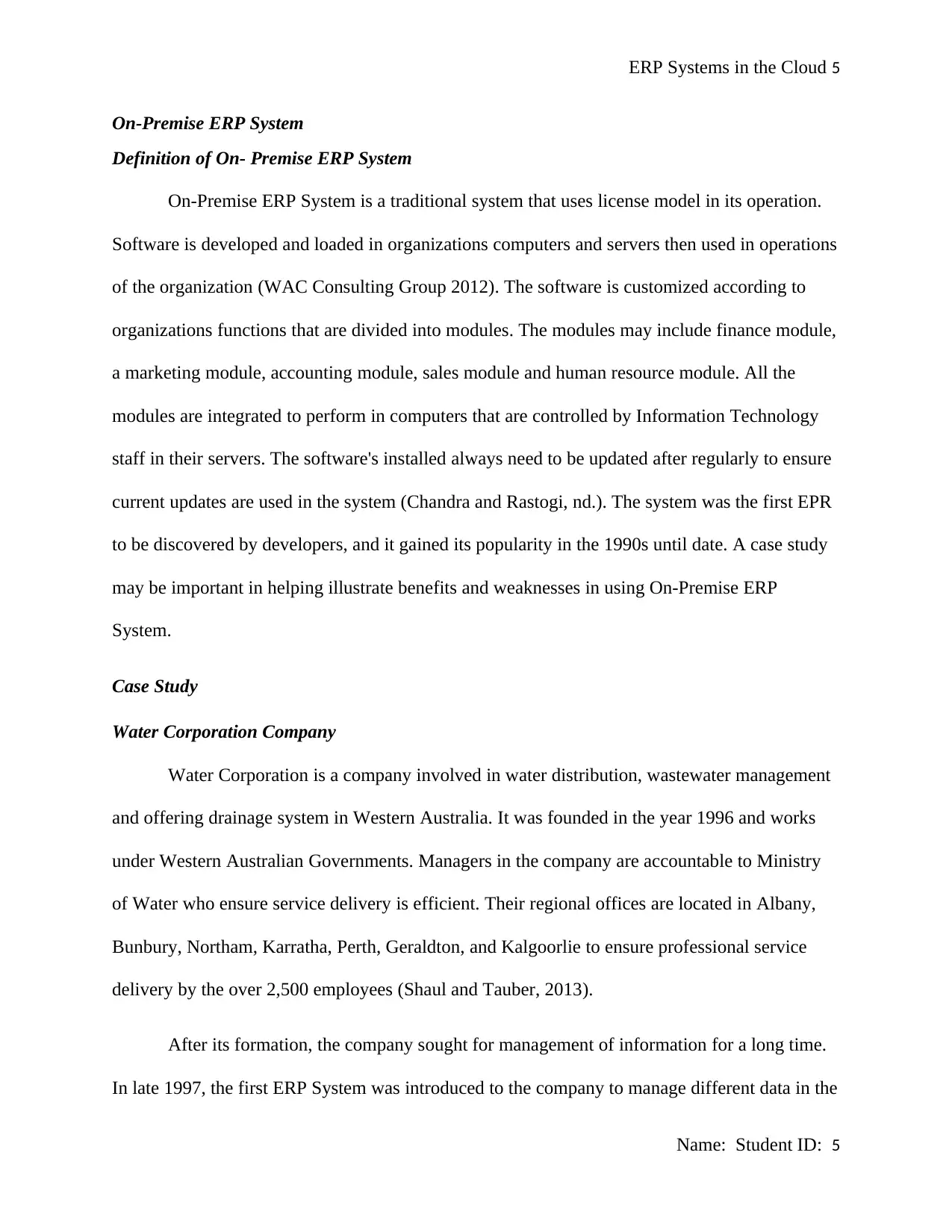
ERP Systems in the Cloud 5
On-Premise ERP System
Definition of On- Premise ERP System
On-Premise ERP System is a traditional system that uses license model in its operation.
Software is developed and loaded in organizations computers and servers then used in operations
of the organization (WAC Consulting Group 2012). The software is customized according to
organizations functions that are divided into modules. The modules may include finance module,
a marketing module, accounting module, sales module and human resource module. All the
modules are integrated to perform in computers that are controlled by Information Technology
staff in their servers. The software's installed always need to be updated after regularly to ensure
current updates are used in the system (Chandra and Rastogi, nd.). The system was the first EPR
to be discovered by developers, and it gained its popularity in the 1990s until date. A case study
may be important in helping illustrate benefits and weaknesses in using On-Premise ERP
System.
Case Study
Water Corporation Company
Water Corporation is a company involved in water distribution, wastewater management
and offering drainage system in Western Australia. It was founded in the year 1996 and works
under Western Australian Governments. Managers in the company are accountable to Ministry
of Water who ensure service delivery is efficient. Their regional offices are located in Albany,
Bunbury, Northam, Karratha, Perth, Geraldton, and Kalgoorlie to ensure professional service
delivery by the over 2,500 employees (Shaul and Tauber, 2013).
After its formation, the company sought for management of information for a long time.
In late 1997, the first ERP System was introduced to the company to manage different data in the
Name: Student ID: 5
On-Premise ERP System
Definition of On- Premise ERP System
On-Premise ERP System is a traditional system that uses license model in its operation.
Software is developed and loaded in organizations computers and servers then used in operations
of the organization (WAC Consulting Group 2012). The software is customized according to
organizations functions that are divided into modules. The modules may include finance module,
a marketing module, accounting module, sales module and human resource module. All the
modules are integrated to perform in computers that are controlled by Information Technology
staff in their servers. The software's installed always need to be updated after regularly to ensure
current updates are used in the system (Chandra and Rastogi, nd.). The system was the first EPR
to be discovered by developers, and it gained its popularity in the 1990s until date. A case study
may be important in helping illustrate benefits and weaknesses in using On-Premise ERP
System.
Case Study
Water Corporation Company
Water Corporation is a company involved in water distribution, wastewater management
and offering drainage system in Western Australia. It was founded in the year 1996 and works
under Western Australian Governments. Managers in the company are accountable to Ministry
of Water who ensure service delivery is efficient. Their regional offices are located in Albany,
Bunbury, Northam, Karratha, Perth, Geraldton, and Kalgoorlie to ensure professional service
delivery by the over 2,500 employees (Shaul and Tauber, 2013).
After its formation, the company sought for management of information for a long time.
In late 1997, the first ERP System was introduced to the company to manage different data in the
Name: Student ID: 5
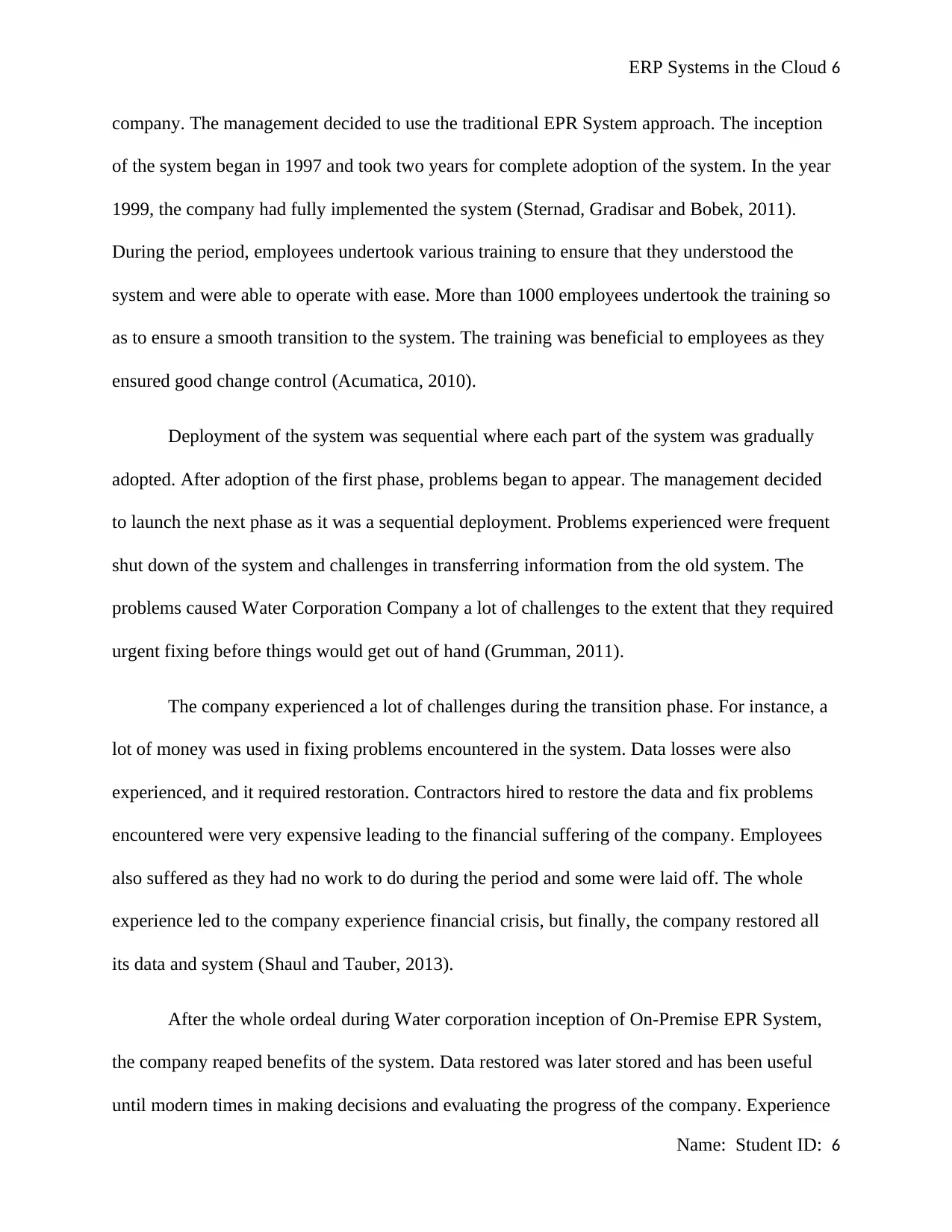
ERP Systems in the Cloud 6
company. The management decided to use the traditional EPR System approach. The inception
of the system began in 1997 and took two years for complete adoption of the system. In the year
1999, the company had fully implemented the system (Sternad, Gradisar and Bobek, 2011).
During the period, employees undertook various training to ensure that they understood the
system and were able to operate with ease. More than 1000 employees undertook the training so
as to ensure a smooth transition to the system. The training was beneficial to employees as they
ensured good change control (Acumatica, 2010).
Deployment of the system was sequential where each part of the system was gradually
adopted. After adoption of the first phase, problems began to appear. The management decided
to launch the next phase as it was a sequential deployment. Problems experienced were frequent
shut down of the system and challenges in transferring information from the old system. The
problems caused Water Corporation Company a lot of challenges to the extent that they required
urgent fixing before things would get out of hand (Grumman, 2011).
The company experienced a lot of challenges during the transition phase. For instance, a
lot of money was used in fixing problems encountered in the system. Data losses were also
experienced, and it required restoration. Contractors hired to restore the data and fix problems
encountered were very expensive leading to the financial suffering of the company. Employees
also suffered as they had no work to do during the period and some were laid off. The whole
experience led to the company experience financial crisis, but finally, the company restored all
its data and system (Shaul and Tauber, 2013).
After the whole ordeal during Water corporation inception of On-Premise EPR System,
the company reaped benefits of the system. Data restored was later stored and has been useful
until modern times in making decisions and evaluating the progress of the company. Experience
Name: Student ID: 6
company. The management decided to use the traditional EPR System approach. The inception
of the system began in 1997 and took two years for complete adoption of the system. In the year
1999, the company had fully implemented the system (Sternad, Gradisar and Bobek, 2011).
During the period, employees undertook various training to ensure that they understood the
system and were able to operate with ease. More than 1000 employees undertook the training so
as to ensure a smooth transition to the system. The training was beneficial to employees as they
ensured good change control (Acumatica, 2010).
Deployment of the system was sequential where each part of the system was gradually
adopted. After adoption of the first phase, problems began to appear. The management decided
to launch the next phase as it was a sequential deployment. Problems experienced were frequent
shut down of the system and challenges in transferring information from the old system. The
problems caused Water Corporation Company a lot of challenges to the extent that they required
urgent fixing before things would get out of hand (Grumman, 2011).
The company experienced a lot of challenges during the transition phase. For instance, a
lot of money was used in fixing problems encountered in the system. Data losses were also
experienced, and it required restoration. Contractors hired to restore the data and fix problems
encountered were very expensive leading to the financial suffering of the company. Employees
also suffered as they had no work to do during the period and some were laid off. The whole
experience led to the company experience financial crisis, but finally, the company restored all
its data and system (Shaul and Tauber, 2013).
After the whole ordeal during Water corporation inception of On-Premise EPR System,
the company reaped benefits of the system. Data restored was later stored and has been useful
until modern times in making decisions and evaluating the progress of the company. Experience
Name: Student ID: 6
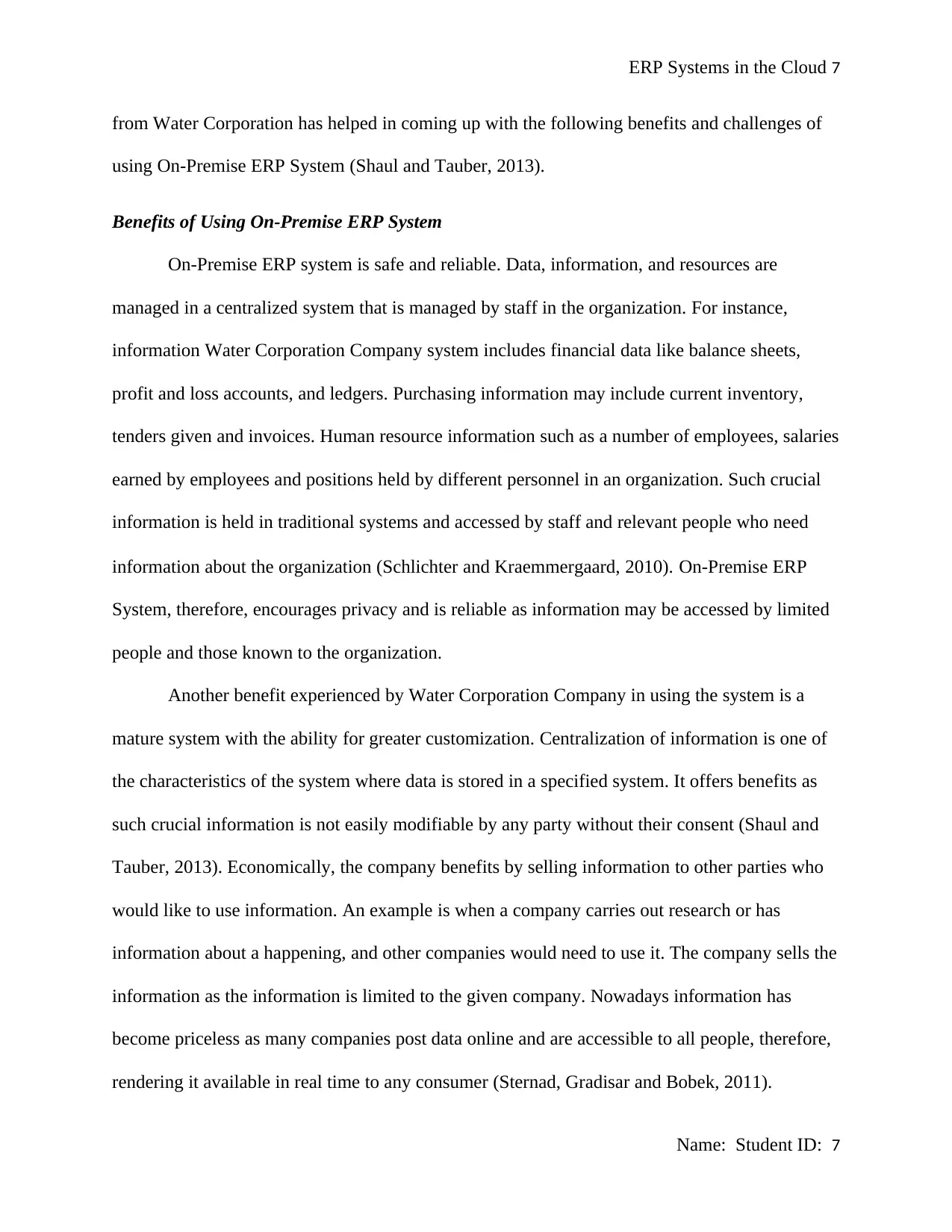
ERP Systems in the Cloud 7
from Water Corporation has helped in coming up with the following benefits and challenges of
using On-Premise ERP System (Shaul and Tauber, 2013).
Benefits of Using On-Premise ERP System
On-Premise ERP system is safe and reliable. Data, information, and resources are
managed in a centralized system that is managed by staff in the organization. For instance,
information Water Corporation Company system includes financial data like balance sheets,
profit and loss accounts, and ledgers. Purchasing information may include current inventory,
tenders given and invoices. Human resource information such as a number of employees, salaries
earned by employees and positions held by different personnel in an organization. Such crucial
information is held in traditional systems and accessed by staff and relevant people who need
information about the organization (Schlichter and Kraemmergaard, 2010). On-Premise ERP
System, therefore, encourages privacy and is reliable as information may be accessed by limited
people and those known to the organization.
Another benefit experienced by Water Corporation Company in using the system is a
mature system with the ability for greater customization. Centralization of information is one of
the characteristics of the system where data is stored in a specified system. It offers benefits as
such crucial information is not easily modifiable by any party without their consent (Shaul and
Tauber, 2013). Economically, the company benefits by selling information to other parties who
would like to use information. An example is when a company carries out research or has
information about a happening, and other companies would need to use it. The company sells the
information as the information is limited to the given company. Nowadays information has
become priceless as many companies post data online and are accessible to all people, therefore,
rendering it available in real time to any consumer (Sternad, Gradisar and Bobek, 2011).
Name: Student ID: 7
from Water Corporation has helped in coming up with the following benefits and challenges of
using On-Premise ERP System (Shaul and Tauber, 2013).
Benefits of Using On-Premise ERP System
On-Premise ERP system is safe and reliable. Data, information, and resources are
managed in a centralized system that is managed by staff in the organization. For instance,
information Water Corporation Company system includes financial data like balance sheets,
profit and loss accounts, and ledgers. Purchasing information may include current inventory,
tenders given and invoices. Human resource information such as a number of employees, salaries
earned by employees and positions held by different personnel in an organization. Such crucial
information is held in traditional systems and accessed by staff and relevant people who need
information about the organization (Schlichter and Kraemmergaard, 2010). On-Premise ERP
System, therefore, encourages privacy and is reliable as information may be accessed by limited
people and those known to the organization.
Another benefit experienced by Water Corporation Company in using the system is a
mature system with the ability for greater customization. Centralization of information is one of
the characteristics of the system where data is stored in a specified system. It offers benefits as
such crucial information is not easily modifiable by any party without their consent (Shaul and
Tauber, 2013). Economically, the company benefits by selling information to other parties who
would like to use information. An example is when a company carries out research or has
information about a happening, and other companies would need to use it. The company sells the
information as the information is limited to the given company. Nowadays information has
become priceless as many companies post data online and are accessible to all people, therefore,
rendering it available in real time to any consumer (Sternad, Gradisar and Bobek, 2011).
Name: Student ID: 7
Paraphrase This Document
Need a fresh take? Get an instant paraphrase of this document with our AI Paraphraser
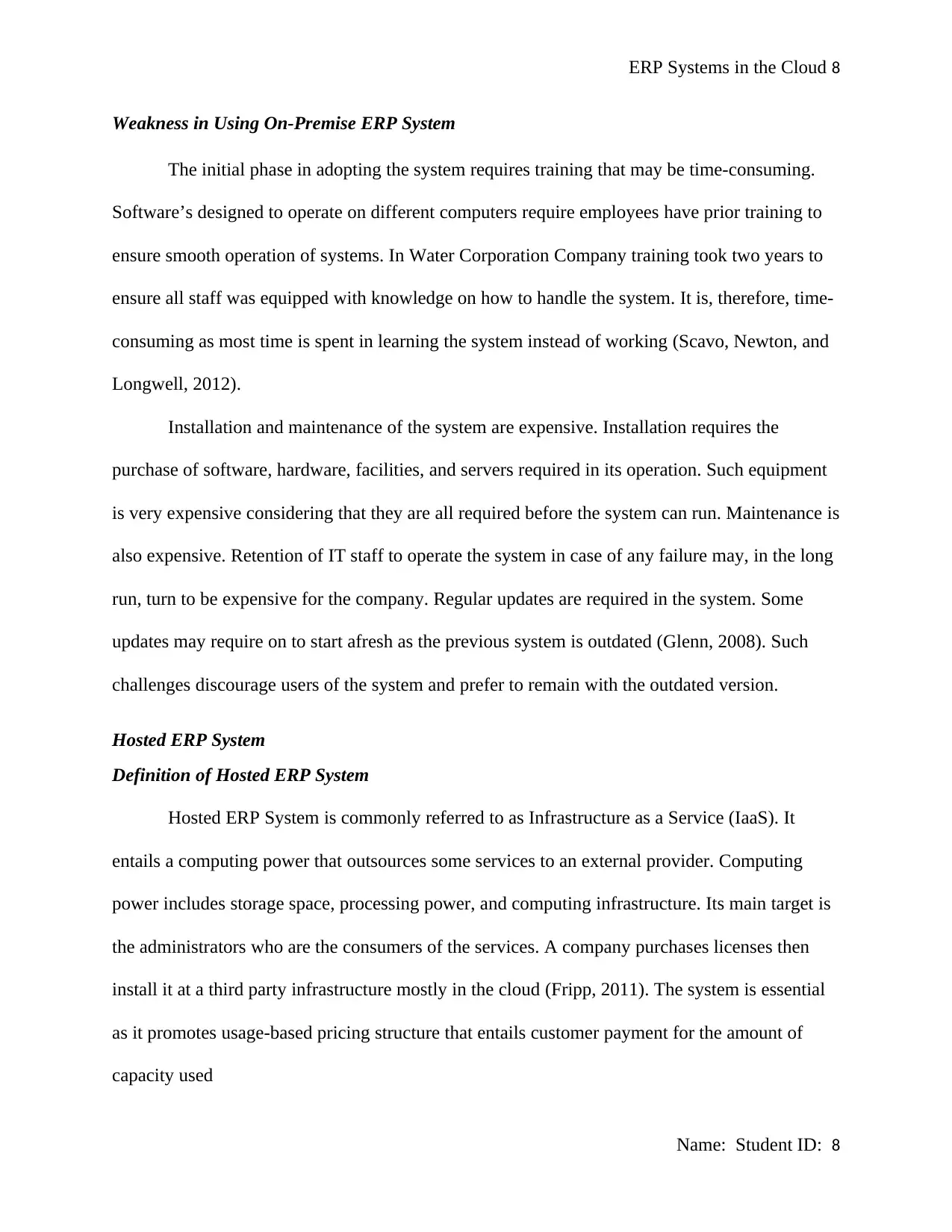
ERP Systems in the Cloud 8
Weakness in Using On-Premise ERP System
The initial phase in adopting the system requires training that may be time-consuming.
Software’s designed to operate on different computers require employees have prior training to
ensure smooth operation of systems. In Water Corporation Company training took two years to
ensure all staff was equipped with knowledge on how to handle the system. It is, therefore, time-
consuming as most time is spent in learning the system instead of working (Scavo, Newton, and
Longwell, 2012).
Installation and maintenance of the system are expensive. Installation requires the
purchase of software, hardware, facilities, and servers required in its operation. Such equipment
is very expensive considering that they are all required before the system can run. Maintenance is
also expensive. Retention of IT staff to operate the system in case of any failure may, in the long
run, turn to be expensive for the company. Regular updates are required in the system. Some
updates may require on to start afresh as the previous system is outdated (Glenn, 2008). Such
challenges discourage users of the system and prefer to remain with the outdated version.
Hosted ERP System
Definition of Hosted ERP System
Hosted ERP System is commonly referred to as Infrastructure as a Service (IaaS). It
entails a computing power that outsources some services to an external provider. Computing
power includes storage space, processing power, and computing infrastructure. Its main target is
the administrators who are the consumers of the services. A company purchases licenses then
install it at a third party infrastructure mostly in the cloud (Fripp, 2011). The system is essential
as it promotes usage-based pricing structure that entails customer payment for the amount of
capacity used
Name: Student ID: 8
Weakness in Using On-Premise ERP System
The initial phase in adopting the system requires training that may be time-consuming.
Software’s designed to operate on different computers require employees have prior training to
ensure smooth operation of systems. In Water Corporation Company training took two years to
ensure all staff was equipped with knowledge on how to handle the system. It is, therefore, time-
consuming as most time is spent in learning the system instead of working (Scavo, Newton, and
Longwell, 2012).
Installation and maintenance of the system are expensive. Installation requires the
purchase of software, hardware, facilities, and servers required in its operation. Such equipment
is very expensive considering that they are all required before the system can run. Maintenance is
also expensive. Retention of IT staff to operate the system in case of any failure may, in the long
run, turn to be expensive for the company. Regular updates are required in the system. Some
updates may require on to start afresh as the previous system is outdated (Glenn, 2008). Such
challenges discourage users of the system and prefer to remain with the outdated version.
Hosted ERP System
Definition of Hosted ERP System
Hosted ERP System is commonly referred to as Infrastructure as a Service (IaaS). It
entails a computing power that outsources some services to an external provider. Computing
power includes storage space, processing power, and computing infrastructure. Its main target is
the administrators who are the consumers of the services. A company purchases licenses then
install it at a third party infrastructure mostly in the cloud (Fripp, 2011). The system is essential
as it promotes usage-based pricing structure that entails customer payment for the amount of
capacity used
Name: Student ID: 8

ERP Systems in the Cloud 9
Case Study
Scottish Fire and Rescue Services (SFRS)
Scottish Fire and Rescue Services (SFRS) is an emergency response organization
operating in Scotland. Formed in the year 2013 it unites more than 9000 firefighters drawn from
different fire station across Scotland. Its main duty is rescuing people in collapsed buildings,
motor vehicle accident and fire mitigation to save lives and property (Scavo, Newton and
Longwell, 2012).
One of the mandates of SFRS is the reduction of duplicate services and cost reduction.
After being assigned the mandate, the first challenge was the integration of the eight backup
solutions to a single platform using IT infrastructure. SFRS first used Microsoft Exchange 2010,
SQL, SharePoint and Oracle to have a data backup but it never solved the challenge. They
carried thorough environmental assessment on existing systems that would integrate the data
they had. SFRS found solutions in using Commvault Simpana software a hosted ERP System in
data management. Its simplicity and functionality have been successfully implemented by the
company for the last five year, and SFRS reports positive feedback about the software (Rong et
al., 2012).
Benefits of using Hosted ERP System
The system is easy to use and access. Information is hosted in Commvault Simpana
which is easy to operate therefore business can easily transfer information on their operations
easily to the cloud. No codes required for the activity. The only important requirement is the
stable internet connection. Accessibility is easy as users work from any part of the world. Local
and global offices can always operate therefore boosting productivity in employees (Karabek,
Kleinert and Pohl, 2011).
Name: Student ID: 9
Case Study
Scottish Fire and Rescue Services (SFRS)
Scottish Fire and Rescue Services (SFRS) is an emergency response organization
operating in Scotland. Formed in the year 2013 it unites more than 9000 firefighters drawn from
different fire station across Scotland. Its main duty is rescuing people in collapsed buildings,
motor vehicle accident and fire mitigation to save lives and property (Scavo, Newton and
Longwell, 2012).
One of the mandates of SFRS is the reduction of duplicate services and cost reduction.
After being assigned the mandate, the first challenge was the integration of the eight backup
solutions to a single platform using IT infrastructure. SFRS first used Microsoft Exchange 2010,
SQL, SharePoint and Oracle to have a data backup but it never solved the challenge. They
carried thorough environmental assessment on existing systems that would integrate the data
they had. SFRS found solutions in using Commvault Simpana software a hosted ERP System in
data management. Its simplicity and functionality have been successfully implemented by the
company for the last five year, and SFRS reports positive feedback about the software (Rong et
al., 2012).
Benefits of using Hosted ERP System
The system is easy to use and access. Information is hosted in Commvault Simpana
which is easy to operate therefore business can easily transfer information on their operations
easily to the cloud. No codes required for the activity. The only important requirement is the
stable internet connection. Accessibility is easy as users work from any part of the world. Local
and global offices can always operate therefore boosting productivity in employees (Karabek,
Kleinert and Pohl, 2011).
Name: Student ID: 9
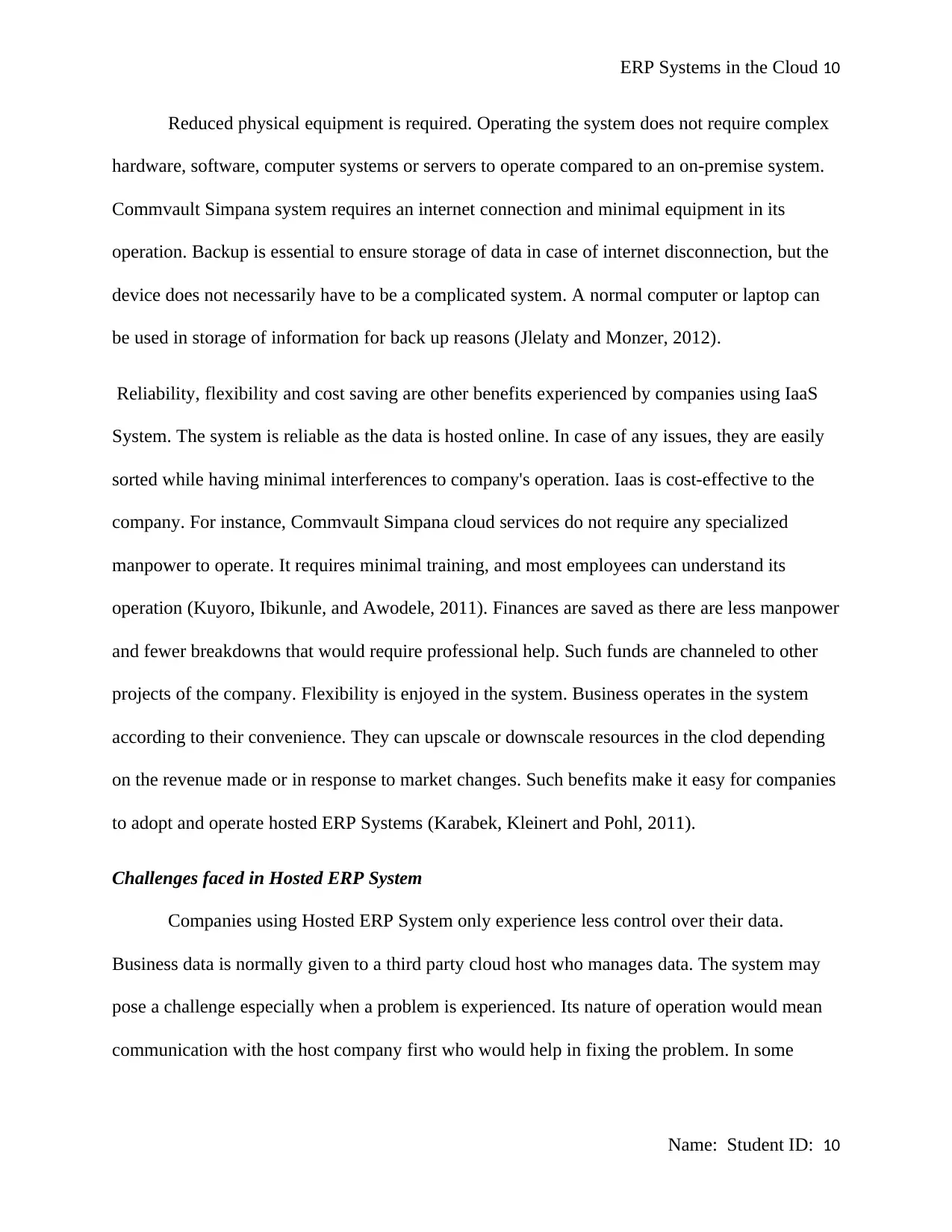
ERP Systems in the Cloud 10
Reduced physical equipment is required. Operating the system does not require complex
hardware, software, computer systems or servers to operate compared to an on-premise system.
Commvault Simpana system requires an internet connection and minimal equipment in its
operation. Backup is essential to ensure storage of data in case of internet disconnection, but the
device does not necessarily have to be a complicated system. A normal computer or laptop can
be used in storage of information for back up reasons (Jlelaty and Monzer, 2012).
Reliability, flexibility and cost saving are other benefits experienced by companies using IaaS
System. The system is reliable as the data is hosted online. In case of any issues, they are easily
sorted while having minimal interferences to company's operation. Iaas is cost-effective to the
company. For instance, Commvault Simpana cloud services do not require any specialized
manpower to operate. It requires minimal training, and most employees can understand its
operation (Kuyoro, Ibikunle, and Awodele, 2011). Finances are saved as there are less manpower
and fewer breakdowns that would require professional help. Such funds are channeled to other
projects of the company. Flexibility is enjoyed in the system. Business operates in the system
according to their convenience. They can upscale or downscale resources in the clod depending
on the revenue made or in response to market changes. Such benefits make it easy for companies
to adopt and operate hosted ERP Systems (Karabek, Kleinert and Pohl, 2011).
Challenges faced in Hosted ERP System
Companies using Hosted ERP System only experience less control over their data.
Business data is normally given to a third party cloud host who manages data. The system may
pose a challenge especially when a problem is experienced. Its nature of operation would mean
communication with the host company first who would help in fixing the problem. In some
Name: Student ID: 10
Reduced physical equipment is required. Operating the system does not require complex
hardware, software, computer systems or servers to operate compared to an on-premise system.
Commvault Simpana system requires an internet connection and minimal equipment in its
operation. Backup is essential to ensure storage of data in case of internet disconnection, but the
device does not necessarily have to be a complicated system. A normal computer or laptop can
be used in storage of information for back up reasons (Jlelaty and Monzer, 2012).
Reliability, flexibility and cost saving are other benefits experienced by companies using IaaS
System. The system is reliable as the data is hosted online. In case of any issues, they are easily
sorted while having minimal interferences to company's operation. Iaas is cost-effective to the
company. For instance, Commvault Simpana cloud services do not require any specialized
manpower to operate. It requires minimal training, and most employees can understand its
operation (Kuyoro, Ibikunle, and Awodele, 2011). Finances are saved as there are less manpower
and fewer breakdowns that would require professional help. Such funds are channeled to other
projects of the company. Flexibility is enjoyed in the system. Business operates in the system
according to their convenience. They can upscale or downscale resources in the clod depending
on the revenue made or in response to market changes. Such benefits make it easy for companies
to adopt and operate hosted ERP Systems (Karabek, Kleinert and Pohl, 2011).
Challenges faced in Hosted ERP System
Companies using Hosted ERP System only experience less control over their data.
Business data is normally given to a third party cloud host who manages data. The system may
pose a challenge especially when a problem is experienced. Its nature of operation would mean
communication with the host company first who would help in fixing the problem. In some
Name: Student ID: 10
Secure Best Marks with AI Grader
Need help grading? Try our AI Grader for instant feedback on your assignments.
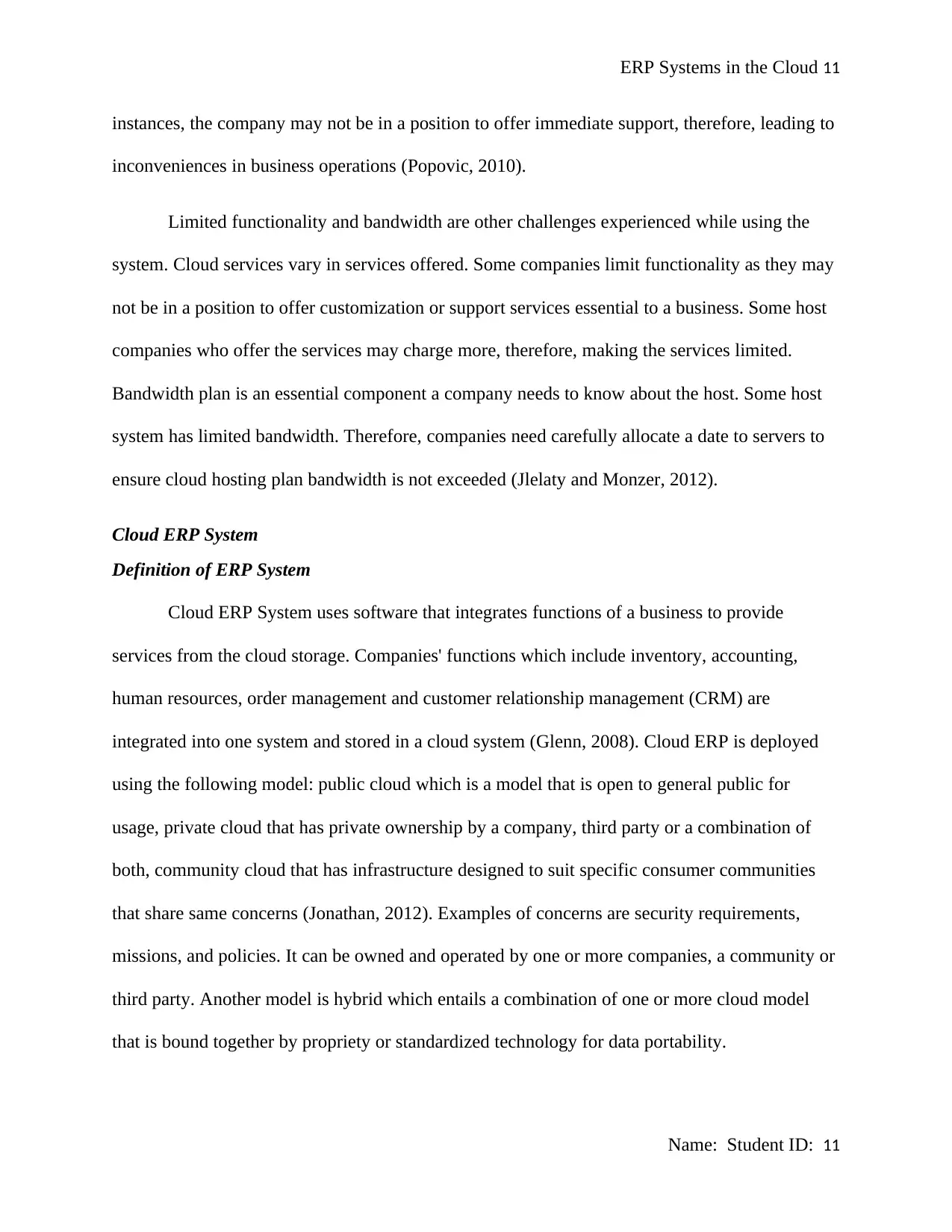
ERP Systems in the Cloud 11
instances, the company may not be in a position to offer immediate support, therefore, leading to
inconveniences in business operations (Popovic, 2010).
Limited functionality and bandwidth are other challenges experienced while using the
system. Cloud services vary in services offered. Some companies limit functionality as they may
not be in a position to offer customization or support services essential to a business. Some host
companies who offer the services may charge more, therefore, making the services limited.
Bandwidth plan is an essential component a company needs to know about the host. Some host
system has limited bandwidth. Therefore, companies need carefully allocate a date to servers to
ensure cloud hosting plan bandwidth is not exceeded (Jlelaty and Monzer, 2012).
Cloud ERP System
Definition of ERP System
Cloud ERP System uses software that integrates functions of a business to provide
services from the cloud storage. Companies' functions which include inventory, accounting,
human resources, order management and customer relationship management (CRM) are
integrated into one system and stored in a cloud system (Glenn, 2008). Cloud ERP is deployed
using the following model: public cloud which is a model that is open to general public for
usage, private cloud that has private ownership by a company, third party or a combination of
both, community cloud that has infrastructure designed to suit specific consumer communities
that share same concerns (Jonathan, 2012). Examples of concerns are security requirements,
missions, and policies. It can be owned and operated by one or more companies, a community or
third party. Another model is hybrid which entails a combination of one or more cloud model
that is bound together by propriety or standardized technology for data portability.
Name: Student ID: 11
instances, the company may not be in a position to offer immediate support, therefore, leading to
inconveniences in business operations (Popovic, 2010).
Limited functionality and bandwidth are other challenges experienced while using the
system. Cloud services vary in services offered. Some companies limit functionality as they may
not be in a position to offer customization or support services essential to a business. Some host
companies who offer the services may charge more, therefore, making the services limited.
Bandwidth plan is an essential component a company needs to know about the host. Some host
system has limited bandwidth. Therefore, companies need carefully allocate a date to servers to
ensure cloud hosting plan bandwidth is not exceeded (Jlelaty and Monzer, 2012).
Cloud ERP System
Definition of ERP System
Cloud ERP System uses software that integrates functions of a business to provide
services from the cloud storage. Companies' functions which include inventory, accounting,
human resources, order management and customer relationship management (CRM) are
integrated into one system and stored in a cloud system (Glenn, 2008). Cloud ERP is deployed
using the following model: public cloud which is a model that is open to general public for
usage, private cloud that has private ownership by a company, third party or a combination of
both, community cloud that has infrastructure designed to suit specific consumer communities
that share same concerns (Jonathan, 2012). Examples of concerns are security requirements,
missions, and policies. It can be owned and operated by one or more companies, a community or
third party. Another model is hybrid which entails a combination of one or more cloud model
that is bound together by propriety or standardized technology for data portability.
Name: Student ID: 11
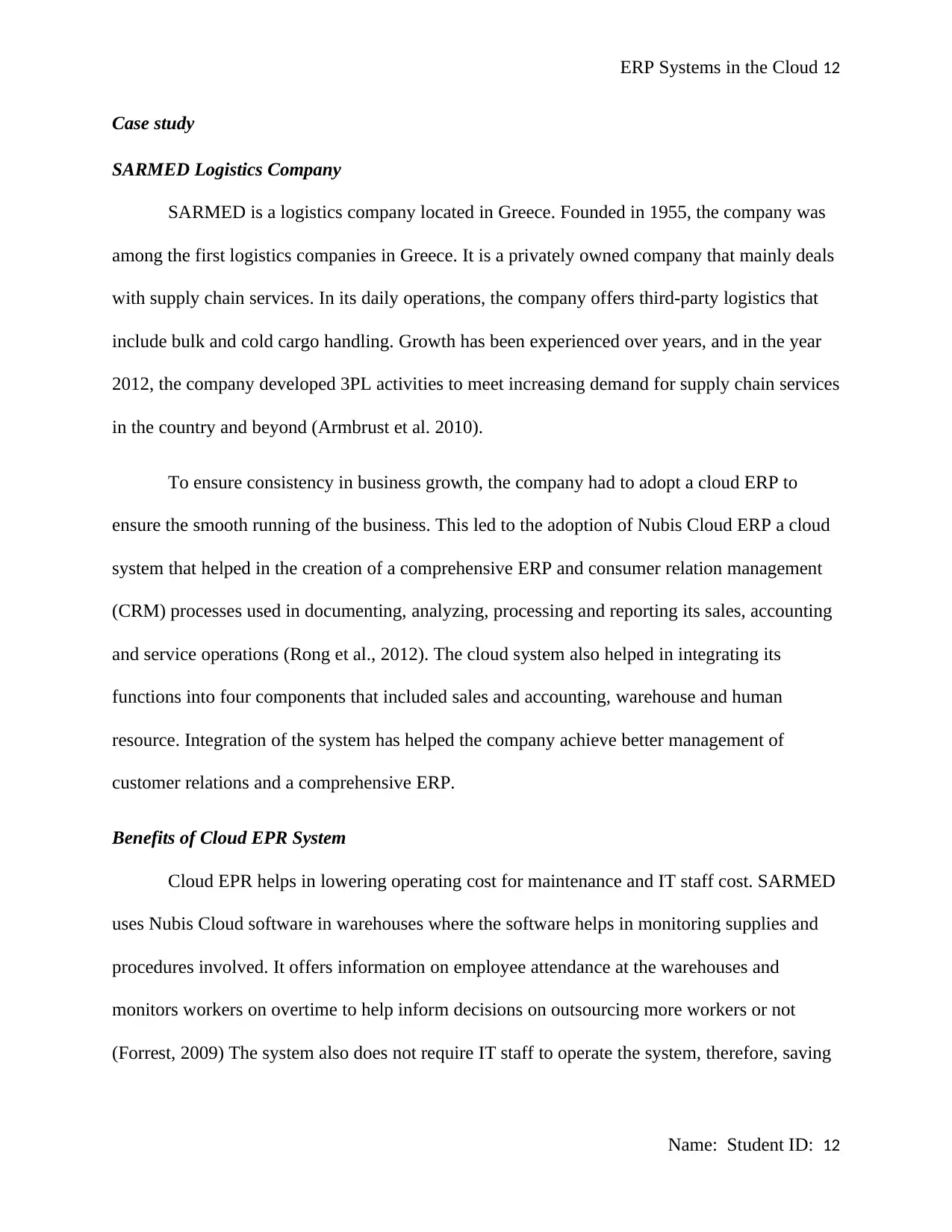
ERP Systems in the Cloud 12
Case study
SARMED Logistics Company
SARMED is a logistics company located in Greece. Founded in 1955, the company was
among the first logistics companies in Greece. It is a privately owned company that mainly deals
with supply chain services. In its daily operations, the company offers third-party logistics that
include bulk and cold cargo handling. Growth has been experienced over years, and in the year
2012, the company developed 3PL activities to meet increasing demand for supply chain services
in the country and beyond (Armbrust et al. 2010).
To ensure consistency in business growth, the company had to adopt a cloud ERP to
ensure the smooth running of the business. This led to the adoption of Nubis Cloud ERP a cloud
system that helped in the creation of a comprehensive ERP and consumer relation management
(CRM) processes used in documenting, analyzing, processing and reporting its sales, accounting
and service operations (Rong et al., 2012). The cloud system also helped in integrating its
functions into four components that included sales and accounting, warehouse and human
resource. Integration of the system has helped the company achieve better management of
customer relations and a comprehensive ERP.
Benefits of Cloud EPR System
Cloud EPR helps in lowering operating cost for maintenance and IT staff cost. SARMED
uses Nubis Cloud software in warehouses where the software helps in monitoring supplies and
procedures involved. It offers information on employee attendance at the warehouses and
monitors workers on overtime to help inform decisions on outsourcing more workers or not
(Forrest, 2009) The system also does not require IT staff to operate the system, therefore, saving
Name: Student ID: 12
Case study
SARMED Logistics Company
SARMED is a logistics company located in Greece. Founded in 1955, the company was
among the first logistics companies in Greece. It is a privately owned company that mainly deals
with supply chain services. In its daily operations, the company offers third-party logistics that
include bulk and cold cargo handling. Growth has been experienced over years, and in the year
2012, the company developed 3PL activities to meet increasing demand for supply chain services
in the country and beyond (Armbrust et al. 2010).
To ensure consistency in business growth, the company had to adopt a cloud ERP to
ensure the smooth running of the business. This led to the adoption of Nubis Cloud ERP a cloud
system that helped in the creation of a comprehensive ERP and consumer relation management
(CRM) processes used in documenting, analyzing, processing and reporting its sales, accounting
and service operations (Rong et al., 2012). The cloud system also helped in integrating its
functions into four components that included sales and accounting, warehouse and human
resource. Integration of the system has helped the company achieve better management of
customer relations and a comprehensive ERP.
Benefits of Cloud EPR System
Cloud EPR helps in lowering operating cost for maintenance and IT staff cost. SARMED
uses Nubis Cloud software in warehouses where the software helps in monitoring supplies and
procedures involved. It offers information on employee attendance at the warehouses and
monitors workers on overtime to help inform decisions on outsourcing more workers or not
(Forrest, 2009) The system also does not require IT staff to operate the system, therefore, saving
Name: Student ID: 12
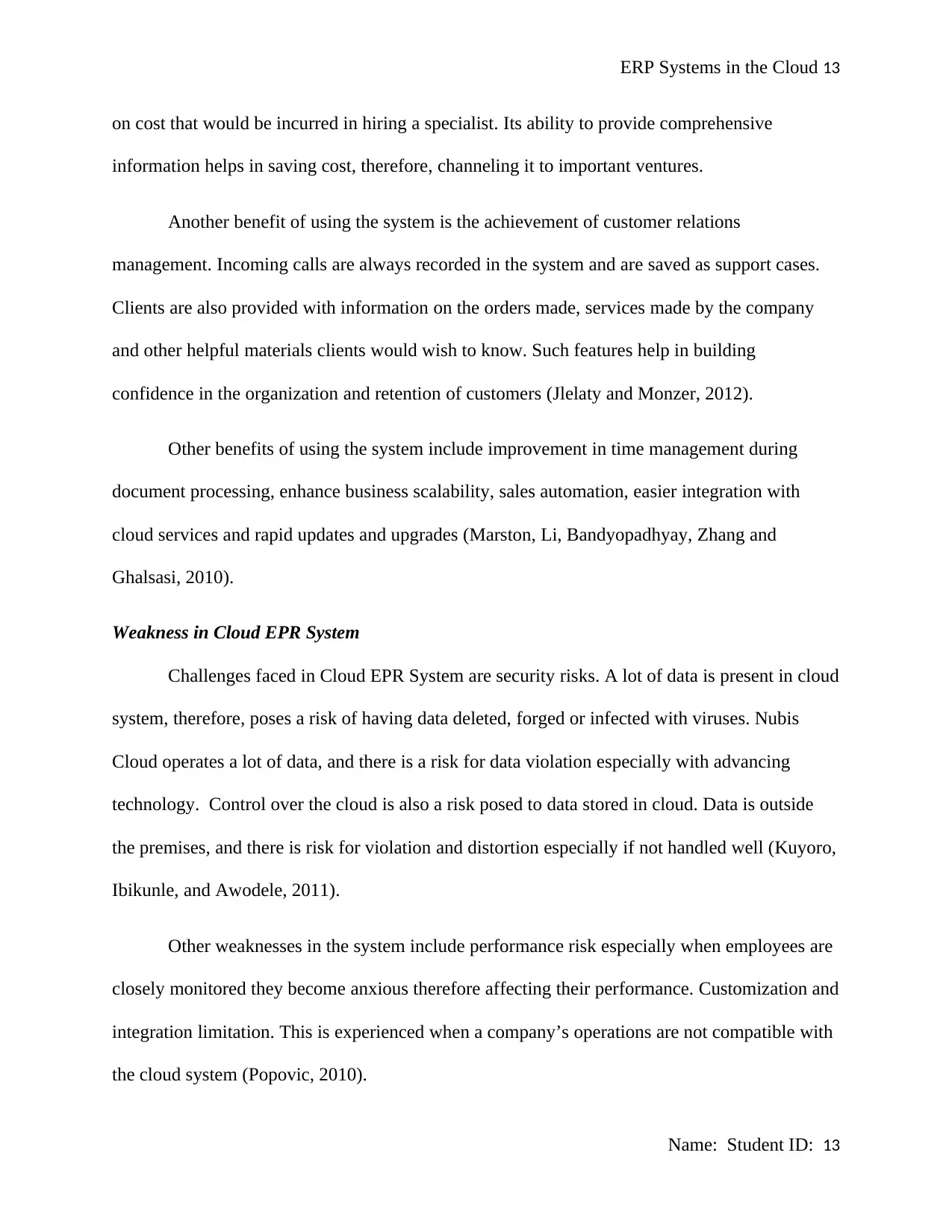
ERP Systems in the Cloud 13
on cost that would be incurred in hiring a specialist. Its ability to provide comprehensive
information helps in saving cost, therefore, channeling it to important ventures.
Another benefit of using the system is the achievement of customer relations
management. Incoming calls are always recorded in the system and are saved as support cases.
Clients are also provided with information on the orders made, services made by the company
and other helpful materials clients would wish to know. Such features help in building
confidence in the organization and retention of customers (Jlelaty and Monzer, 2012).
Other benefits of using the system include improvement in time management during
document processing, enhance business scalability, sales automation, easier integration with
cloud services and rapid updates and upgrades (Marston, Li, Bandyopadhyay, Zhang and
Ghalsasi, 2010).
Weakness in Cloud EPR System
Challenges faced in Cloud EPR System are security risks. A lot of data is present in cloud
system, therefore, poses a risk of having data deleted, forged or infected with viruses. Nubis
Cloud operates a lot of data, and there is a risk for data violation especially with advancing
technology. Control over the cloud is also a risk posed to data stored in cloud. Data is outside
the premises, and there is risk for violation and distortion especially if not handled well (Kuyoro,
Ibikunle, and Awodele, 2011).
Other weaknesses in the system include performance risk especially when employees are
closely monitored they become anxious therefore affecting their performance. Customization and
integration limitation. This is experienced when a company’s operations are not compatible with
the cloud system (Popovic, 2010).
Name: Student ID: 13
on cost that would be incurred in hiring a specialist. Its ability to provide comprehensive
information helps in saving cost, therefore, channeling it to important ventures.
Another benefit of using the system is the achievement of customer relations
management. Incoming calls are always recorded in the system and are saved as support cases.
Clients are also provided with information on the orders made, services made by the company
and other helpful materials clients would wish to know. Such features help in building
confidence in the organization and retention of customers (Jlelaty and Monzer, 2012).
Other benefits of using the system include improvement in time management during
document processing, enhance business scalability, sales automation, easier integration with
cloud services and rapid updates and upgrades (Marston, Li, Bandyopadhyay, Zhang and
Ghalsasi, 2010).
Weakness in Cloud EPR System
Challenges faced in Cloud EPR System are security risks. A lot of data is present in cloud
system, therefore, poses a risk of having data deleted, forged or infected with viruses. Nubis
Cloud operates a lot of data, and there is a risk for data violation especially with advancing
technology. Control over the cloud is also a risk posed to data stored in cloud. Data is outside
the premises, and there is risk for violation and distortion especially if not handled well (Kuyoro,
Ibikunle, and Awodele, 2011).
Other weaknesses in the system include performance risk especially when employees are
closely monitored they become anxious therefore affecting their performance. Customization and
integration limitation. This is experienced when a company’s operations are not compatible with
the cloud system (Popovic, 2010).
Name: Student ID: 13
Paraphrase This Document
Need a fresh take? Get an instant paraphrase of this document with our AI Paraphraser
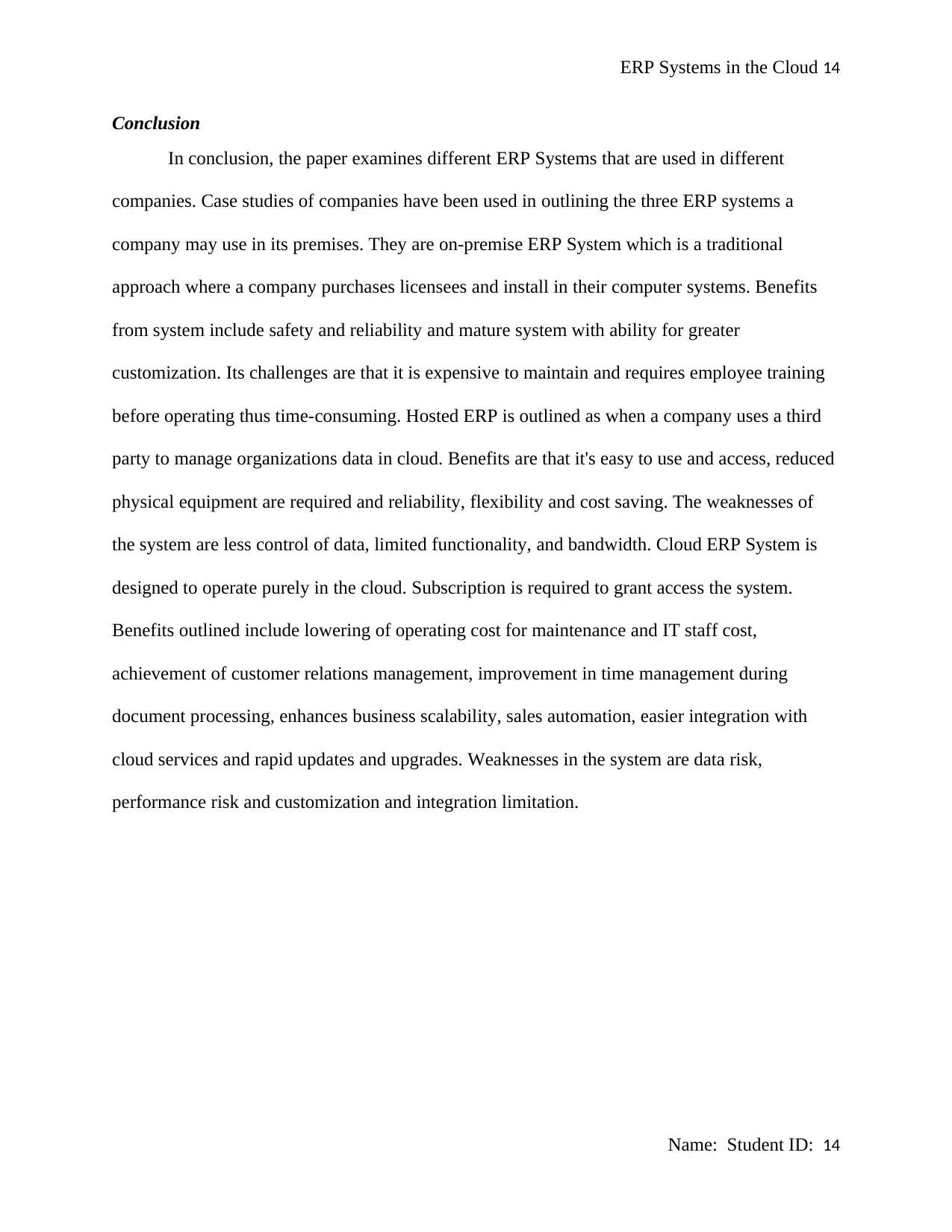
ERP Systems in the Cloud 14
Conclusion
In conclusion, the paper examines different ERP Systems that are used in different
companies. Case studies of companies have been used in outlining the three ERP systems a
company may use in its premises. They are on-premise ERP System which is a traditional
approach where a company purchases licensees and install in their computer systems. Benefits
from system include safety and reliability and mature system with ability for greater
customization. Its challenges are that it is expensive to maintain and requires employee training
before operating thus time-consuming. Hosted ERP is outlined as when a company uses a third
party to manage organizations data in cloud. Benefits are that it's easy to use and access, reduced
physical equipment are required and reliability, flexibility and cost saving. The weaknesses of
the system are less control of data, limited functionality, and bandwidth. Cloud ERP System is
designed to operate purely in the cloud. Subscription is required to grant access the system.
Benefits outlined include lowering of operating cost for maintenance and IT staff cost,
achievement of customer relations management, improvement in time management during
document processing, enhances business scalability, sales automation, easier integration with
cloud services and rapid updates and upgrades. Weaknesses in the system are data risk,
performance risk and customization and integration limitation.
Name: Student ID: 14
Conclusion
In conclusion, the paper examines different ERP Systems that are used in different
companies. Case studies of companies have been used in outlining the three ERP systems a
company may use in its premises. They are on-premise ERP System which is a traditional
approach where a company purchases licensees and install in their computer systems. Benefits
from system include safety and reliability and mature system with ability for greater
customization. Its challenges are that it is expensive to maintain and requires employee training
before operating thus time-consuming. Hosted ERP is outlined as when a company uses a third
party to manage organizations data in cloud. Benefits are that it's easy to use and access, reduced
physical equipment are required and reliability, flexibility and cost saving. The weaknesses of
the system are less control of data, limited functionality, and bandwidth. Cloud ERP System is
designed to operate purely in the cloud. Subscription is required to grant access the system.
Benefits outlined include lowering of operating cost for maintenance and IT staff cost,
achievement of customer relations management, improvement in time management during
document processing, enhances business scalability, sales automation, easier integration with
cloud services and rapid updates and upgrades. Weaknesses in the system are data risk,
performance risk and customization and integration limitation.
Name: Student ID: 14
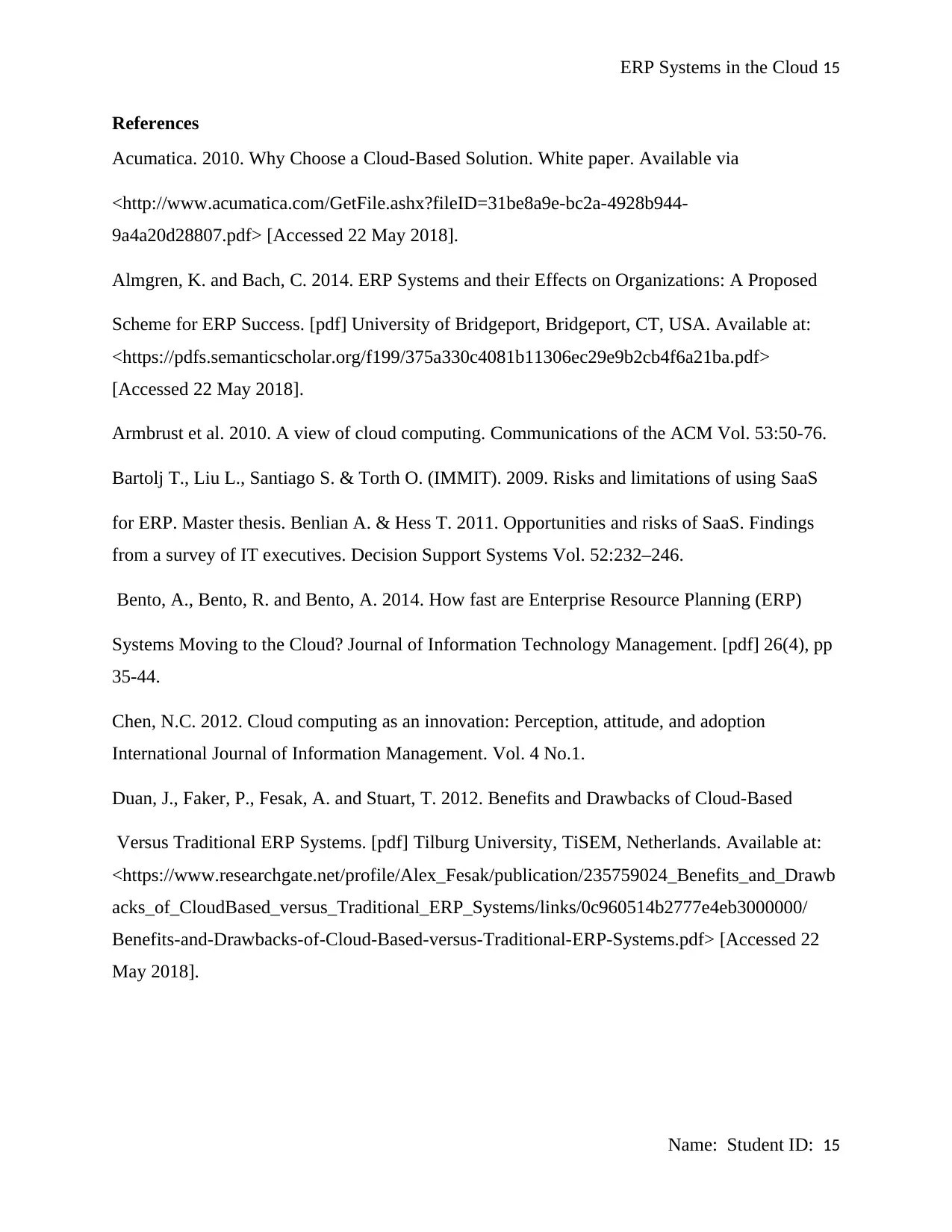
ERP Systems in the Cloud 15
References
Acumatica. 2010. Why Choose a Cloud-Based Solution. White paper. Available via
<http://www.acumatica.com/GetFile.ashx?fileID=31be8a9e-bc2a-4928b944-
9a4a20d28807.pdf> [Accessed 22 May 2018].
Almgren, K. and Bach, C. 2014. ERP Systems and their Effects on Organizations: A Proposed
Scheme for ERP Success. [pdf] University of Bridgeport, Bridgeport, CT, USA. Available at:
<https://pdfs.semanticscholar.org/f199/375a330c4081b11306ec29e9b2cb4f6a21ba.pdf>
[Accessed 22 May 2018].
Armbrust et al. 2010. A view of cloud computing. Communications of the ACM Vol. 53:50-76.
Bartolj T., Liu L., Santiago S. & Torth O. (IMMIT). 2009. Risks and limitations of using SaaS
for ERP. Master thesis. Benlian A. & Hess T. 2011. Opportunities and risks of SaaS. Findings
from a survey of IT executives. Decision Support Systems Vol. 52:232–246.
Bento, A., Bento, R. and Bento, A. 2014. How fast are Enterprise Resource Planning (ERP)
Systems Moving to the Cloud? Journal of Information Technology Management. [pdf] 26(4), pp
35-44.
Chen, N.C. 2012. Cloud computing as an innovation: Perception, attitude, and adoption
International Journal of Information Management. Vol. 4 No.1.
Duan, J., Faker, P., Fesak, A. and Stuart, T. 2012. Benefits and Drawbacks of Cloud-Based
Versus Traditional ERP Systems. [pdf] Tilburg University, TiSEM, Netherlands. Available at:
<https://www.researchgate.net/profile/Alex_Fesak/publication/235759024_Benefits_and_Drawb
acks_of_CloudBased_versus_Traditional_ERP_Systems/links/0c960514b2777e4eb3000000/
Benefits-and-Drawbacks-of-Cloud-Based-versus-Traditional-ERP-Systems.pdf> [Accessed 22
May 2018].
Name: Student ID: 15
References
Acumatica. 2010. Why Choose a Cloud-Based Solution. White paper. Available via
<http://www.acumatica.com/GetFile.ashx?fileID=31be8a9e-bc2a-4928b944-
9a4a20d28807.pdf> [Accessed 22 May 2018].
Almgren, K. and Bach, C. 2014. ERP Systems and their Effects on Organizations: A Proposed
Scheme for ERP Success. [pdf] University of Bridgeport, Bridgeport, CT, USA. Available at:
<https://pdfs.semanticscholar.org/f199/375a330c4081b11306ec29e9b2cb4f6a21ba.pdf>
[Accessed 22 May 2018].
Armbrust et al. 2010. A view of cloud computing. Communications of the ACM Vol. 53:50-76.
Bartolj T., Liu L., Santiago S. & Torth O. (IMMIT). 2009. Risks and limitations of using SaaS
for ERP. Master thesis. Benlian A. & Hess T. 2011. Opportunities and risks of SaaS. Findings
from a survey of IT executives. Decision Support Systems Vol. 52:232–246.
Bento, A., Bento, R. and Bento, A. 2014. How fast are Enterprise Resource Planning (ERP)
Systems Moving to the Cloud? Journal of Information Technology Management. [pdf] 26(4), pp
35-44.
Chen, N.C. 2012. Cloud computing as an innovation: Perception, attitude, and adoption
International Journal of Information Management. Vol. 4 No.1.
Duan, J., Faker, P., Fesak, A. and Stuart, T. 2012. Benefits and Drawbacks of Cloud-Based
Versus Traditional ERP Systems. [pdf] Tilburg University, TiSEM, Netherlands. Available at:
<https://www.researchgate.net/profile/Alex_Fesak/publication/235759024_Benefits_and_Drawb
acks_of_CloudBased_versus_Traditional_ERP_Systems/links/0c960514b2777e4eb3000000/
Benefits-and-Drawbacks-of-Cloud-Based-versus-Traditional-ERP-Systems.pdf> [Accessed 22
May 2018].
Name: Student ID: 15
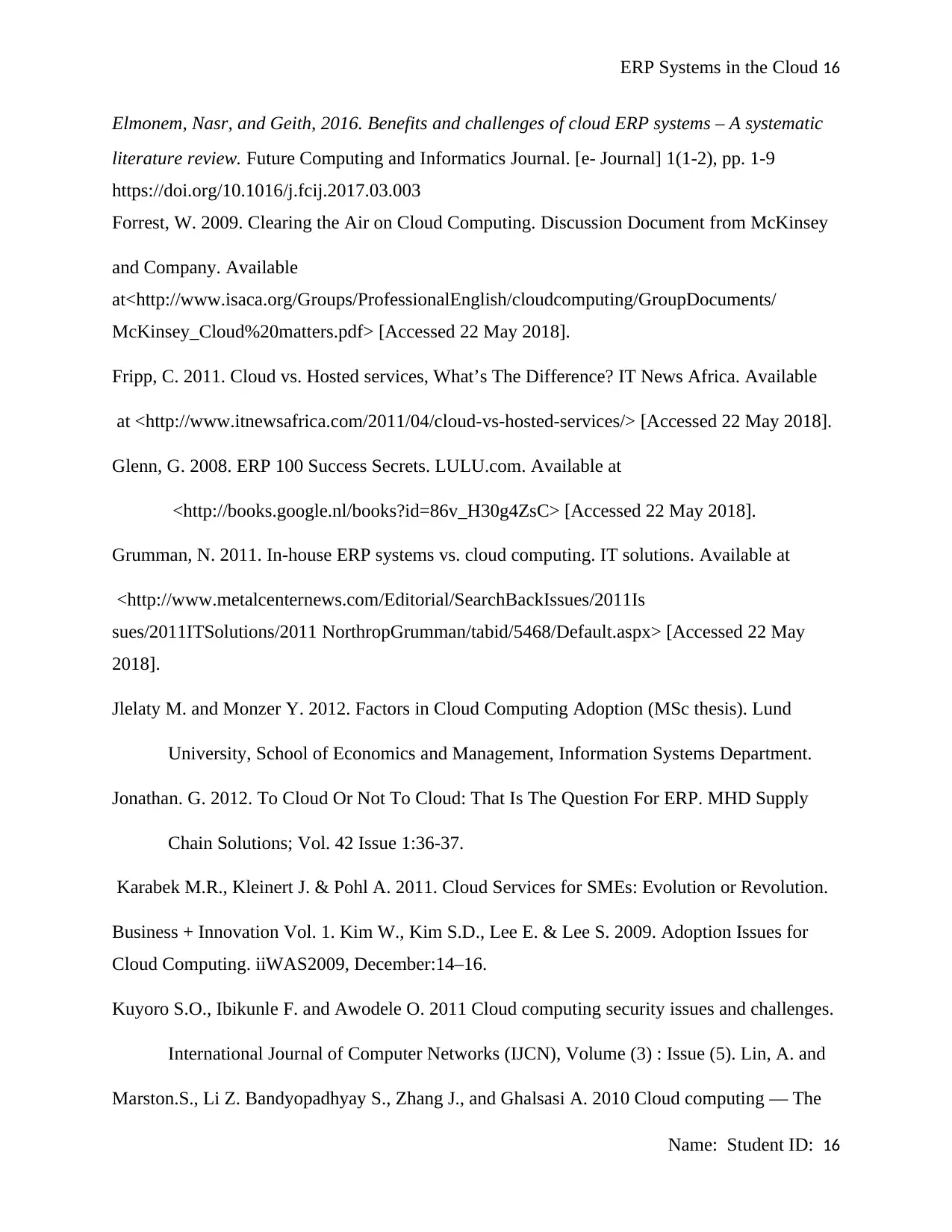
ERP Systems in the Cloud 16
Elmonem, Nasr, and Geith, 2016. Benefits and challenges of cloud ERP systems – A systematic
literature review. Future Computing and Informatics Journal. [e- Journal] 1(1-2), pp. 1-9
https://doi.org/10.1016/j.fcij.2017.03.003
Forrest, W. 2009. Clearing the Air on Cloud Computing. Discussion Document from McKinsey
and Company. Available
at<http://www.isaca.org/Groups/ProfessionalEnglish/cloudcomputing/GroupDocuments/
McKinsey_Cloud%20matters.pdf> [Accessed 22 May 2018].
Fripp, C. 2011. Cloud vs. Hosted services, What’s The Difference? IT News Africa. Available
at <http://www.itnewsafrica.com/2011/04/cloud-vs-hosted-services/> [Accessed 22 May 2018].
Glenn, G. 2008. ERP 100 Success Secrets. LULU.com. Available at
<http://books.google.nl/books?id=86v_H30g4ZsC> [Accessed 22 May 2018].
Grumman, N. 2011. In-house ERP systems vs. cloud computing. IT solutions. Available at
<http://www.metalcenternews.com/Editorial/SearchBackIssues/2011Is
sues/2011ITSolutions/2011 NorthropGrumman/tabid/5468/Default.aspx> [Accessed 22 May
2018].
Jlelaty M. and Monzer Y. 2012. Factors in Cloud Computing Adoption (MSc thesis). Lund
University, School of Economics and Management, Information Systems Department.
Jonathan. G. 2012. To Cloud Or Not To Cloud: That Is The Question For ERP. MHD Supply
Chain Solutions; Vol. 42 Issue 1:36-37.
Karabek M.R., Kleinert J. & Pohl A. 2011. Cloud Services for SMEs: Evolution or Revolution.
Business + Innovation Vol. 1. Kim W., Kim S.D., Lee E. & Lee S. 2009. Adoption Issues for
Cloud Computing. iiWAS2009, December:14–16.
Kuyoro S.O., Ibikunle F. and Awodele O. 2011 Cloud computing security issues and challenges.
International Journal of Computer Networks (IJCN), Volume (3) : Issue (5). Lin, A. and
Marston.S., Li Z. Bandyopadhyay S., Zhang J., and Ghalsasi A. 2010 Cloud computing — The
Name: Student ID: 16
Elmonem, Nasr, and Geith, 2016. Benefits and challenges of cloud ERP systems – A systematic
literature review. Future Computing and Informatics Journal. [e- Journal] 1(1-2), pp. 1-9
https://doi.org/10.1016/j.fcij.2017.03.003
Forrest, W. 2009. Clearing the Air on Cloud Computing. Discussion Document from McKinsey
and Company. Available
at<http://www.isaca.org/Groups/ProfessionalEnglish/cloudcomputing/GroupDocuments/
McKinsey_Cloud%20matters.pdf> [Accessed 22 May 2018].
Fripp, C. 2011. Cloud vs. Hosted services, What’s The Difference? IT News Africa. Available
at <http://www.itnewsafrica.com/2011/04/cloud-vs-hosted-services/> [Accessed 22 May 2018].
Glenn, G. 2008. ERP 100 Success Secrets. LULU.com. Available at
<http://books.google.nl/books?id=86v_H30g4ZsC> [Accessed 22 May 2018].
Grumman, N. 2011. In-house ERP systems vs. cloud computing. IT solutions. Available at
<http://www.metalcenternews.com/Editorial/SearchBackIssues/2011Is
sues/2011ITSolutions/2011 NorthropGrumman/tabid/5468/Default.aspx> [Accessed 22 May
2018].
Jlelaty M. and Monzer Y. 2012. Factors in Cloud Computing Adoption (MSc thesis). Lund
University, School of Economics and Management, Information Systems Department.
Jonathan. G. 2012. To Cloud Or Not To Cloud: That Is The Question For ERP. MHD Supply
Chain Solutions; Vol. 42 Issue 1:36-37.
Karabek M.R., Kleinert J. & Pohl A. 2011. Cloud Services for SMEs: Evolution or Revolution.
Business + Innovation Vol. 1. Kim W., Kim S.D., Lee E. & Lee S. 2009. Adoption Issues for
Cloud Computing. iiWAS2009, December:14–16.
Kuyoro S.O., Ibikunle F. and Awodele O. 2011 Cloud computing security issues and challenges.
International Journal of Computer Networks (IJCN), Volume (3) : Issue (5). Lin, A. and
Marston.S., Li Z. Bandyopadhyay S., Zhang J., and Ghalsasi A. 2010 Cloud computing — The
Name: Student ID: 16
Secure Best Marks with AI Grader
Need help grading? Try our AI Grader for instant feedback on your assignments.
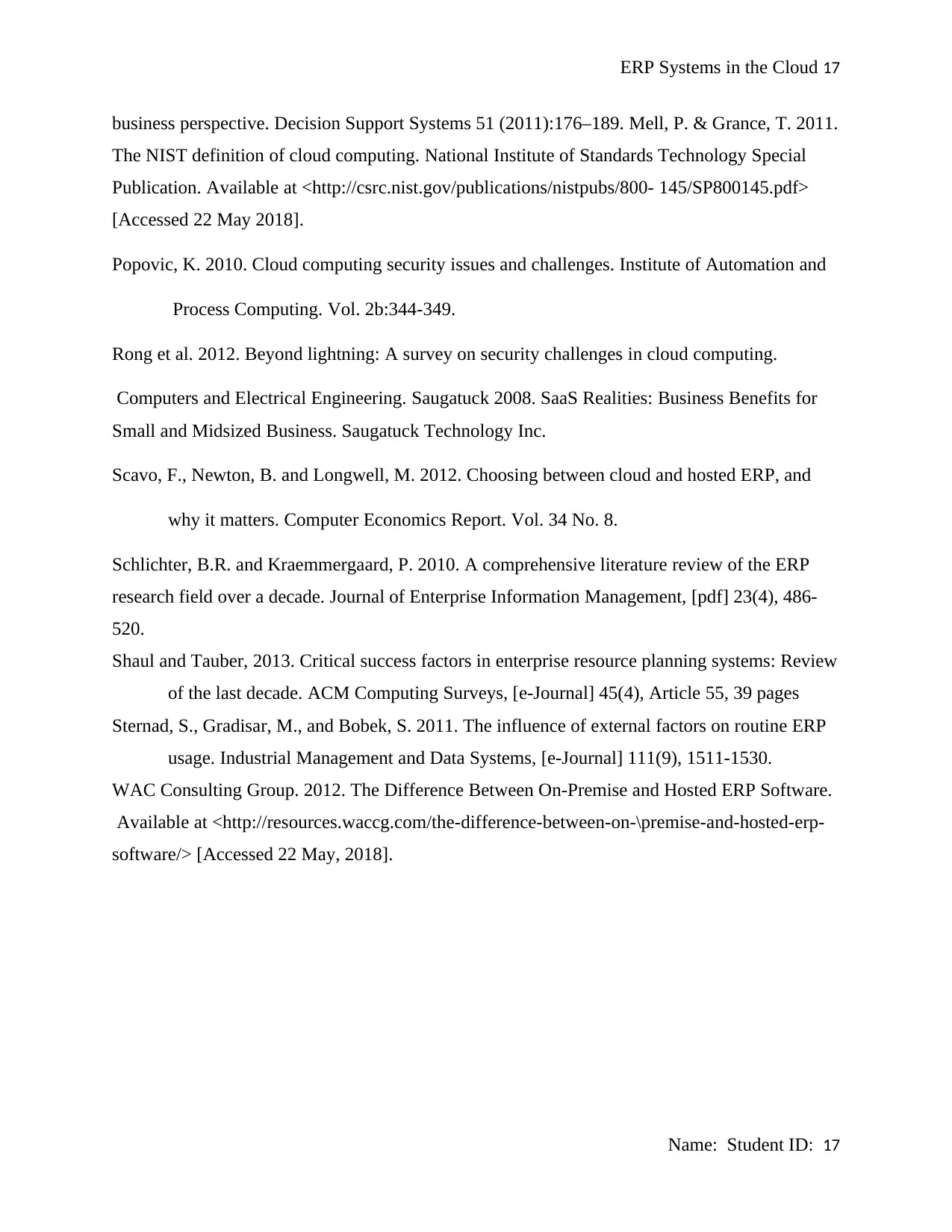
ERP Systems in the Cloud 17
business perspective. Decision Support Systems 51 (2011):176–189. Mell, P. & Grance, T. 2011.
The NIST definition of cloud computing. National Institute of Standards Technology Special
Publication. Available at <http://csrc.nist.gov/publications/nistpubs/800- 145/SP800145.pdf>
[Accessed 22 May 2018].
Popovic, K. 2010. Cloud computing security issues and challenges. Institute of Automation and
Process Computing. Vol. 2b:344-349.
Rong et al. 2012. Beyond lightning: A survey on security challenges in cloud computing.
Computers and Electrical Engineering. Saugatuck 2008. SaaS Realities: Business Benefits for
Small and Midsized Business. Saugatuck Technology Inc.
Scavo, F., Newton, B. and Longwell, M. 2012. Choosing between cloud and hosted ERP, and
why it matters. Computer Economics Report. Vol. 34 No. 8.
Schlichter, B.R. and Kraemmergaard, P. 2010. A comprehensive literature review of the ERP
research field over a decade. Journal of Enterprise Information Management, [pdf] 23(4), 486-
520.
Shaul and Tauber, 2013. Critical success factors in enterprise resource planning systems: Review
of the last decade. ACM Computing Surveys, [e-Journal] 45(4), Article 55, 39 pages
Sternad, S., Gradisar, M., and Bobek, S. 2011. The influence of external factors on routine ERP
usage. Industrial Management and Data Systems, [e-Journal] 111(9), 1511-1530.
WAC Consulting Group. 2012. The Difference Between On-Premise and Hosted ERP Software.
Available at <http://resources.waccg.com/the-difference-between-on-\premise-and-hosted-erp-
software/> [Accessed 22 May, 2018].
Name: Student ID: 17
business perspective. Decision Support Systems 51 (2011):176–189. Mell, P. & Grance, T. 2011.
The NIST definition of cloud computing. National Institute of Standards Technology Special
Publication. Available at <http://csrc.nist.gov/publications/nistpubs/800- 145/SP800145.pdf>
[Accessed 22 May 2018].
Popovic, K. 2010. Cloud computing security issues and challenges. Institute of Automation and
Process Computing. Vol. 2b:344-349.
Rong et al. 2012. Beyond lightning: A survey on security challenges in cloud computing.
Computers and Electrical Engineering. Saugatuck 2008. SaaS Realities: Business Benefits for
Small and Midsized Business. Saugatuck Technology Inc.
Scavo, F., Newton, B. and Longwell, M. 2012. Choosing between cloud and hosted ERP, and
why it matters. Computer Economics Report. Vol. 34 No. 8.
Schlichter, B.R. and Kraemmergaard, P. 2010. A comprehensive literature review of the ERP
research field over a decade. Journal of Enterprise Information Management, [pdf] 23(4), 486-
520.
Shaul and Tauber, 2013. Critical success factors in enterprise resource planning systems: Review
of the last decade. ACM Computing Surveys, [e-Journal] 45(4), Article 55, 39 pages
Sternad, S., Gradisar, M., and Bobek, S. 2011. The influence of external factors on routine ERP
usage. Industrial Management and Data Systems, [e-Journal] 111(9), 1511-1530.
WAC Consulting Group. 2012. The Difference Between On-Premise and Hosted ERP Software.
Available at <http://resources.waccg.com/the-difference-between-on-\premise-and-hosted-erp-
software/> [Accessed 22 May, 2018].
Name: Student ID: 17
1 out of 17
Related Documents
Your All-in-One AI-Powered Toolkit for Academic Success.
+13062052269
info@desklib.com
Available 24*7 on WhatsApp / Email
![[object Object]](/_next/static/media/star-bottom.7253800d.svg)
Unlock your academic potential
© 2024 | Zucol Services PVT LTD | All rights reserved.



